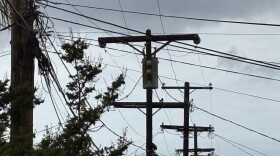Alert California is a firefighting tool that stretches across the state. But it doesn’t put out any fires.
Its cameras are at work 24/7 using artificial intelligence technology to search the landscape for signs of smoke so firefighters can stop a wildfire before it really gets started.
“We try to confirm, identify fires in the incipient phase,” said Neal Driscoll, a geology professor at the Scripps Institution of Oceanography who is the founder of Alert California.
“Once (fires) get a hold in windy conditions like this, our networks provide enhanced situational awareness so they can see what roads they can get out. They can see the progression of the fire.”
That network Driscoll is talking about was founded and operated by UC San Diego. It can be seen with a quick look at Alertcalifornia.org.
The website shows the location of 1,146 cameras that are trained on viewsheds that are known to generate fires.
Lately the Southern California end of it had its cameras pointed at conflagrations like the Eaton Fire and the Palisades Fire in LA county. And the Lilac Fire in San Diego that ignited overnight this week.
At night, Driscoll says the cameras focus on the fire. But in daylight, when heat and low humidity make fires more combustible, they look for the smoke.
“This gives you enhanced situational awareness of what the fire’s doing,” Driscoll said as he showed footage of the Hughes Fire north of Los Angeles unfolding in real time.
He pointed out the smoke saying it was “laid over” as it appeared to be hugging the ground. That horizontal movement meant the fire was being fueled by strong, dry winds.
Alert California is a system of artificial intelligence that has learned what the angle and behavior of smoke means to the fire’s progression, and how authorities should respond.
“How is the smoke bent over? Do I send two battalions? Do I send three? So the dispatcher is able to use these data and the density of the cameras is such that our viewsheds are getting closer to covering regions of complex topography,” Driscoll said.
He said the alert system often “beats” 911 calls, notifying fire authorities of blazes before anyone calls the emergency number.
San Diego CalFire spokesman Michael Cornette mentioned a recent fire, in a remote part of San Diego County, that was flagged by the alert system. Firefighters responded and put it out before authorities got even one 911 call about it.
“I think (Alert California) is an essential tool in our response to get instant situational awareness, to be able to make decisions based on those conditions. When they discover an anomaly they send us an alert,” Cornette said.
Driscoll says global warming is changing everything, overrunning the old models of fire fighting. He says Alert California is one way to stay on top of that changing reality.






